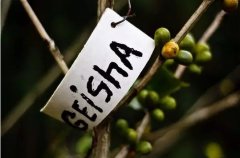Introduction of hand-flushing Flavor of Honey processing Factory of Asali Asalia Cooperative in AA Sika, Kenya
Introduction to AATOP Origin and Cooking of Honey processing Plant of Asali Asalia Cooperative in Sika, Kenya

Kenyan coffee has many followers in the boutique coffee industry, and Kenyan AA has an extraordinary popularity. Kenyan coffee, known as the "Cup of connoisseurs" (Connoisseurs'Cup), is famous in the coffee industry for its rich aroma, bright and vibrant acidity, full and elegant mellowness and red wine flavor. Caffeine in different producing areas has its own subtle flavor due to the difference of microclimate.
Kenyan coffee varieties
Bourbon Bourbon was first brought to Kenya for planting. In the 1950s, the then agricultural research institution ScottLaboratory selected two excellent hybrids, SL-28 and SL-34, through unremitting efforts, subverting the long-standing prejudice of artificial breeding without excellent natural varieties. SL-28 and SL-34 help Kenyan coffee to form its own unique flavor characteristics and establish a perfect reputation in the coffee industry.
According to botanists in SL laboratory, SL28 and SL34 are genetic variants. Among them, SL28 has a mixed pedigree of French missionaries, mochas and Yemens Tibica. The goal of cultivating SL28 was to mass produce coffee beans with high quality and resistance to diseases and insect pests.
Although the yield of SL28 was not as high as expected the copper leaf color and broad bean-shaped beans have great sweetness balance and complex flavor as well as significant citrus and black plum characteristics. SL34 is similar to SL28 in flavor, with a heavier, fuller and cleaner finish than SL28, except for the complex acidity and great sweetness of the finish. SL34 has French missionaries, bourbon, and more Tibica ancestry. Dou looks similar to SL28, but is more adaptable to sudden heavy rain. It is these two important varieties that lead us to the unique Kenyan style: strong acidity, rich taste and beautiful balance.
Coffee growing area
The coffee producing areas in Kenya are mainly concentrated in the plateau areas represented by Mount Mt.Kenya. Tropical climate, acid red volcanic soil provides a natural and suitable growth environment for coffee. It is most famous for seven major producing areas, including Nieri, Sika, Chiambu, Geliniya, Ruiru, Mulanga and the western side of Mount Kenya, with the main producing areas such as Nyeri and Ruiru in the middle.
Kenyan coffee processing
Large farms usually have independent treatment facilities. A large number of small farmers usually pick ripe coffee fruits by hand. Coffee picking is a labor-intensive job that requires the whole family to deploy and even hire workers during the harvest season. The fresh fruit of the picked coffee needs to be delivered in time to the cooperative-owned coffee processing plant for pulping, which may be carried by ox carts, pick-up trucks or trucks. After peeling, Parchmentcoffee is briefly kept in the cooperative's processing plant and sent to a privately owned factory for shelling treatment.
Kenyan coffee grade
Kenya is a well-known producer based on the size of coffee beans. It is usually divided into nine grades, according to the bean type, there are PB (round beans, accounting for about 10% of the total output), in addition, there are E (elephant beans), AA, AB, C, T, TT, MH, ML according to size. The best coffee grade is bean-shaped berry coffee PB, followed by AA++, AA+, AA, AB and so on.
Flavor description:
Strong dry and wet aromas of lemon and plum, shallow baking with floral, lemon and other amazing aromas, fresh citrus, lime, comfortable wood texture of sage, sweet and sour plum juice and candied fruit, caramel aroma at the end.
Suggestion on practical parameters of hand punching
Kenya AA Carlo Goto: 15g powder, medium and fine grinding (small Fuji ghost tooth knife 3.5grind), v60 filter cup, 90-91 degrees water temperature, first water injection 30g water, conduct 30s steaming, water injection to 110g water cut off, wait for powder bed water quantity under half and then water injection, slow water injection until 225g water quantity, tail section no, water-powder ratio 1:15, extraction time 2:12.
Important Notice :
前街咖啡 FrontStreet Coffee has moved to new addredd:
FrontStreet Coffee Address: 315,Donghua East Road,GuangZhou
Tel:020 38364473
- Prev

Characteristics of Indonesian Sumatra Gold Manning G1 Coffee beans hand-baked Mantenin Coffee brewing Flavor
Indonesian gold mantenin handmade flavor characteristics Indonesian coffee is mainly produced in Sumatra, Java and Sulawesi, among which Mantenin from Sumatra is the most famous. Mantenin is also known as Sumatran Coffee. North Sumatra produces mostly Gayo, mainly ateng at the northern end.
- Next

Panama Jensen Estate Coffee Gold Roast Hand Brewed, Siphon Rose Summer Brewing Method
The 2013 Panama Specialty Coffee Association (SCAP) Best Panamanian Coffee Award has a new finalist! It's Carl Jensen's Jensen Manor Geisha variety! Janson Geisha is rarely heard of in Taiwan, because this manor is mainly for domestic sales and not for export; in addition, the manor
Related
- Detailed explanation of Jadeite planting Land in Panamanian Jadeite Manor introduction to the grading system of Jadeite competitive bidding, Red bid, Green bid and Rose Summer
- Story of Coffee planting in Brenka region of Costa Rica Stonehenge Manor anaerobic heavy honey treatment of flavor mouth
- What's on the barrel of Blue Mountain Coffee beans?
- Can American coffee also pull flowers? How to use hot American style to pull out a good-looking pattern?
- Can you make a cold extract with coffee beans? What is the right proportion for cold-extracted coffee formula?
- Indonesian PWN Gold Mandrine Coffee Origin Features Flavor How to Chong? Mandolin coffee is American.
- A brief introduction to the flavor characteristics of Brazilian yellow bourbon coffee beans
- What is the effect of different water quality on the flavor of cold-extracted coffee? What kind of water is best for brewing coffee?
- Why do you think of Rose Summer whenever you mention Panamanian coffee?
- Introduction to the characteristics of authentic blue mountain coffee bean producing areas? What is the CIB Coffee Authority in Jamaica?

